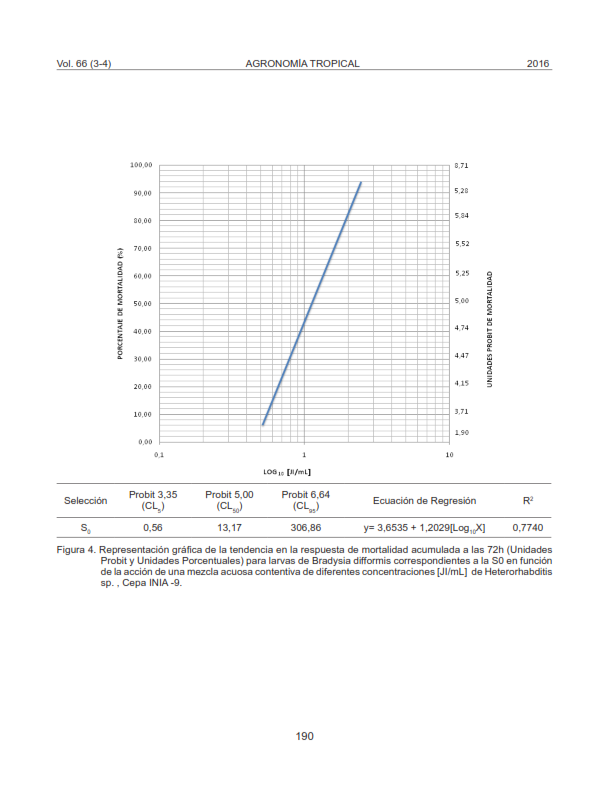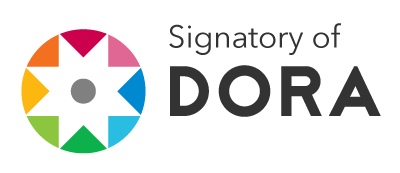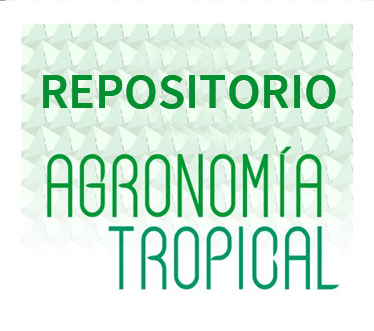Pathogenicity of native entomopathogenic nematodes on two flies of agricultural importance in Venezuela
Abstract
Fruit and vegetable crops are affected by pest insects that reduce production or quality. The use of entomopathogenic nematodes emerges as an alternative control due to its innocuousness to the environment and its easy use. In order to know the potential use of Venezuelan strains, the pathogenicity of three native strains of entomopathogenic nematodes was evaluated on two pests of agricultural interest in the country. Bioassays were carried out using the INIA-4, INIA-9 and INIA-11 strains. Larval stages of Anastrepha obliqua and Bradysia difformis were inoculated. Five doses of each strain were applied (100, 400, 800, 1,200 and 1,600 JI/mL) and insect mortality was determined at 24, 48 and 72 h. Statistic analyses were performed using the Kruskal-Wallis non-parametric test and the pairwise comparison test. Probit analysis was used in order to calculate the LD50. All strains exhibited pathogenicity. Total mortality was obtained in the last instar larvae of A. obliqua (INIA-9 strain) at 80 JI / mL and higher dosis. The Probit Analysis indicates that the INIA11 Strain presented the lowest LD95 value of 28.00 IJ/mL for A. obliqua; followed by the INIA-9 strain with 57.01 IJ/larvae for B. difformis. The results obtained show the potential use of the mentioned nematodes as a biological control over the indicated pests. It also offers a native microorganism that can be massively reproduced and used within an integrated pest management program.
Downloads
References
• Barranco V, P. 2003. Dípteros de interés agronómico. Agromícidos plaga de cultivos hortícolas intensivos. Bol. S.E.A., 33: 293-30.
• Cloyd, R. 2010. Fungus gnat. Management in greenhouses and nurseries. Kansas State University Agricultural Experiment Station and Cooperative Extension Service- MF 2937: 4 p. [On line]. Consultado 29 ene.2015. Disponible en https://bit.ly/2we0UCN
• Da Silva, A; Batista, A;Leite, L; Tavares, F; Raga, A; Schmidt, F. 2009. Efeito de nematoides Entomopatogênicos na Mortalidade da Mosca-do- Mediterrâneo, Ceratitis capitata, e do Gorgulho-da-goiaba, Conotrachelus psidii. Nematologia Brasileira. 34: 31-40.
• De Minas, R.; Dolinski, C; Carvalho, D; de Souza, R. 2011. Controle biológico da mosca-do-mediterraneo Ceratitis capitata utilizando nematoides entomopatogénicos em laboratorio. Scientia Agraria 2:115-119.
• Foelkel, E; Bittencourt M, L; Voss, M. 2016. Virulence of nematodes against larvae of the south-American fruit fly in laboratory using soil from Porto Amazonas, Paraná, Brazil, substrate. Ciência Rural 46(3):405-410.
• García, R ; Zambrano, C. 2007. Uso de control biológico en frutales de Venezuela. Editado por INIA Convenio Integral de Cooperación Cuba Venezuela. ISBN 980-12-2418-5. 370 p.
• Georgis, R; Koppenhöfer, AM; Lacey, LA; Bélair, G; Duncan, LW; Grewal, PG; Samish, G; Tan, L; Torr, P; Van Tol, RW. 2006. Successes and failures in the use of parasitic nematodes for pest control Biological Control. 38:103–123. Consultado 29 ene. 2015. Disponible en https://bit.ly/2HiEsed
• Gouge, G; Hague, D. 1995. The development of Steinernema feltiae (Nematoda: Steinernematidae) in the Sciarid fly Bradysia difformis paupera (Diptera: Sciaridae). Annual Applied Biology 126:395-401.
• Heve, W; El-Borai, F; Carrillo, D; Duncan, L. 2016. Biological control potential of entomopathogenic nematodes for management of Caribbean fruit fly, Anastrepha suspensa Loew (Tephritidae). Consultado 29 ene. 2015. Disponible en https://bit.ly/3bBQKft
• Hyeong, K; Choo, H; Kaya, H; Lee, D; Lee, W; Lee, S; Jeon, H. 2004. Steinernema carpocapsae (Rhabditida: Steinernematidae) as a biological control agent against the fungus Gnat Bradysia difformis agrestis (Diptera: Sciaridae) in propagation houses. Biocontrol Science and Technology 14:7-12.
• Jagdale, G; Casey, M; Grewal, P; Lindquist, RK. 2004. Application rate and timing, potting medium, and host plant effects on the efficacy of Steinernema feltiae against the fungus gnat, Bradysia difformis coprophila, in floriculture. Biological Control. 29: 296 – 305. Consultado 29 ene. 2015. Disponible en: https://bit.ly/2SJqs2f
• López – Nuñez, JC. 2011. Uso de nematodos entomopatógenos en el manejo integrado de la broca del café: Una herramienta para el beneficio de los caficultores. En: Experiencias con nematodos entomopatógenos. Retos y oportunidades para América Latina. Programa Iberoamericano de Ciencia y Tecnología para el desarrollo (CYTED). Red de implementación de enemigos naturales para el control de plagas y enfermedades en cultivos hortícolas de importancia en Iberoamérica COBIHO. Código 111RT0418. ISBN: 978-958-46-1409-4.Pp: 91-100.
• Martins, F. 2010. Avaliacao de nematodides entomopatogenicos no controle de Bradysia difformis mabiusi (Diptera: Sciaridae).Tese apresentada à Faculdade de Ciências Agronômicas da UNESP - Câmpus de Botucatu, para obtenção do título de Doutor em Agronomia (Proteção de Plantas). Botucatu – SP, Brasil. 167 p.
• Pérez, MA; Navarro, H; Miranda E. 2013. Residuos de plaguicidas en hortalizas: problemática y riesgo. Revista Internacional de Contaminación Ambiental 29(4):45-64.
• Quintero, E; López, I; Kondo, T. 2012. Manejo integrado de plagas como estrategia para el control de la mosca del botón floral del maracuyá Dasiops inedulis Steyskal (Diptera: Lonchaeidae). Revista Corpoica - Ciencia y Tecnología Agropecuaria. 13(1):31-40.
• Rosales, LC; Suárez H, Z. 1998. Evaluación de nematodos entomopatógenos como posibles agentes de control biológico contra Cosmopolites sordidus Germar (Coleoptera: Curculionidae). Revista de Entomología Venezolana 13:122-140.
• San-Blas E; Rosales LC; Torres Á. 2015. Entomopathogenic Nematodes in Tropical Agriculture: Current Uses and Their Future in Venezuela. In: Campos-Herrera R. (eds) Nematode Pathogenesis of Insects and Other Pests. Sustainability in Plant and Crop Protection. Springer. Chapter 15:375- 402.
• Stock, P; Goodrich, H. 2012. Nematodes parasites, pathogens and associates of insects and invertebrates of economic importance. In: Manual of Techniques in Invertebrate Pathology Ed. By Lawrence A-Lacey. pp. 373-426.
• Toledo, J; Rasgado, MA; Ibarra, JE; Gómez, A; Liedo, P; William, T. 2006. Infection of Anastrepha ludens following soil applications of Heterorhabditis bacteriophora in a mango orchard. Entomologia Experimentalis et Applicata 119:155–162.
• Toledo,J; Trevor W; Pérez, C; Liedo, P; Valle, J;Ibarra, J. 2009. Factores abióticos que afectan la capacidad de infección de Steinernema carpocapsae (Rhabditida: Steinernematidae) sobre larvas de Anastrepha obliqua (Diptera: Tephritidae). Biocontrol Ciencia y Tecnología 19:887-898.
• Toledo, J; Sánchez, JE; Williams, T; Gómez A; Montoya, P; Ibarra, J. 2014. Effect of Soil Moisture on the Persistence and Efficacy of Heterorhabditis bacteriophora (Rhabditida: Heterorhabditidae) Against Anastrepha ludens (Diptera: Tephritidae) Larvae. Florida Entomologist 97(2):528-533. Consultado 29 ene. 2015. Disponible en: https://bit.ly/2OQiqmY
• Villanueva-Sánchez, E; Ibañez-Bernal, S; Lomeli-Flores, JR; Valdez-Carrasco, J. 2013. Identificación y caracterización de la mosca negra Bradysia difformis difformis (Diptera: Sciaridae) en el cultivo de nochebuena (Euphorbia pulcherrima) en el centro de México. Acta Zoológica Mexicana. 29(2):363-375.
• Xuejuan, F; Maggiorani, A; Gudiño, S. 2000. Uso de nematodos entomopatógenos como una alternativa en el control de polilla (Tecia solanivora), importante plaga de la papa (Solanum tuberosum). Mérida, Venezuela. Revista Forestal Venezolana 44:115 – 118.





